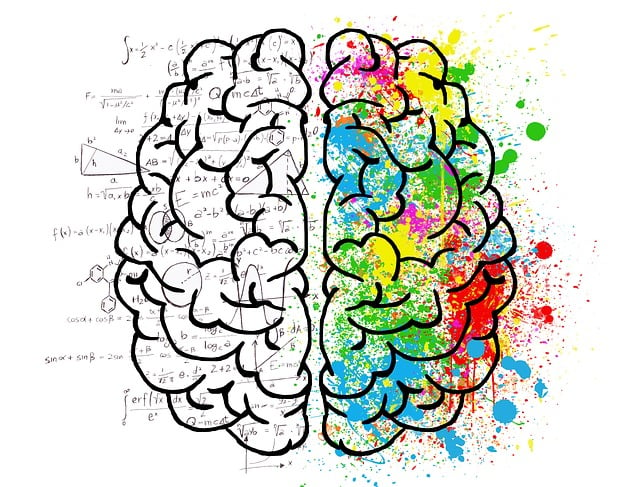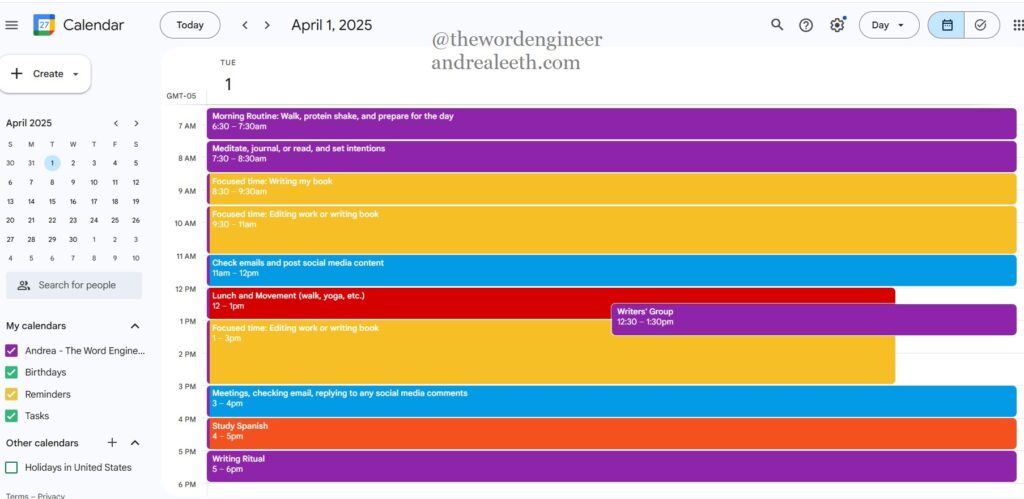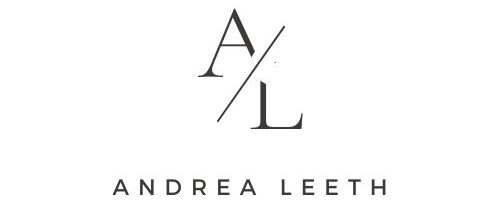How using time-blocking for authors can dramatically improve your writing productivity and help you get into a creative flow state more quickly.
A few weeks ago, I attended the Women in Publishing Summit and sat in on a session that truly left an impact on me, both as a freelance book editor and a writer. The talk was titled “How to Quadruple Your Writing Productivity and Get Into Flow Faster,” by Stacey Ennis, a bestselling author, book coach, and as she calls herself, a Location Independent Entrepreneur.
That last part resonated with me.
I’ve been living nomadically for the past ten years, freelancing for nearly five of them, and like Stacy, all I need is a strong Wi-Fi connection and my laptop to do what I love. But despite this freedom, one thing I’ve learned (and continue to learn) is that productivity isn’t about working more hours. It’s about working with intention, protecting your focus, and building habits that support the creative life you’re trying to build.
This session gave me a fresh framework to do exactly that. So I’m sharing what I learned, not just as a recap, but in the hopes that if you’re also writing a book, growing a business, or simply trying to be more consistent, it might give you the boost you need.

Time-Blocking for Authors: More Focus, Less Burnout
At the heart of Stacy’s talk was the concept of time-blocking, especially for author creativity. It’s a simple but powerful practice: scheduling focused time blocks in your day, in advance, for your highest-priority tasks. Whether that’s writing your book, outlining a course, or like me, editing a fiction novel or nonfiction book, the idea is to protect that time fiercely.
What stood out most to me was the shift in mindset Stacy encouraged: instead of thinking we need massive chunks of time once a week to do a writing session for example, we’re better off doing the task more often with less time. Consistency beats intensity. It’s more so about the frequency and not the duration.
This is especially important if you’re juggling client work and personal writing goals, like I am. Creating a “lifestyle design” calendar, as she calls it, allows you to work with your energy, not against it. For example, I know I’m most mentally alert in the morning, so getting into a flow state for me is better right after my morning routine. This time will be focused on writing my first book or editing a project for a client, all before I check emails, social media, news, etc. You don’t want any outside input or distractions to sneak in and interrupt your flow.

Authors, Protect Your Time-Blocking Focus Like a Mama Bear
One of my favorite metaphors from Stacy’s presentation was this: Protect your discretionary time like a mama bear protects her cubs.
Your discretionary time is that golden window when you focus only on the one thing that moves the needle. Not checking emails. Not multitasking. Not scrolling Instagram or TikTok. It’s sacred.
And research backs this up: Our willpower is highest in the morning and wanes as the day goes on. Of course, everyone is different, but for many of us, morning time is when our brains are fresh, uncluttered, and most capable of deep work.
So how do we protect that time? Stacy suggested a few boundaries:
- Don’t check social media or email until after 11 AM
- Only check emails/socials twice a day
- Block your creative time on your calendar and treat it like a nonnegotiable meeting
These might seem small, but they create powerful ripple effects in how we show up for our work.
Your Brain Is Trainable: The Flow Pathway
Your brain is trainable.
When we build consistent habits, same time, same place, same rituals, we’re not just creating a schedule. We’re creating new neural pathways, what she referred to as your flow pathway. The more you reinforce this pattern, the more easily your brain shifts into focus. The goal is to make flow your default, not a fluke.
But what is flow, exactly?
Flow is a mental state of full immersion in an activity. You know that feeling when time flies, you’re deeply focused, and the work feels effortless? That’s flow. According to research (Van der Linden et al., 2021), it occurs when a few key conditions are met:
- A challenge matches your skill level
- Your attention is fully engaged
- Self-referential thinking (e.g., self-doubt) is quieted
- You feel a sense of control and clarity
- Time feels altered, like it speeds up or slows down
Flow Requires Skill-Challenge Balance
Studies show that flow is most likely when the difficulty of a task aligns with your abilities (Keller, 2016). If the task is too easy, you get bored. If it’s too hard, you get frustrated or shut down. This balance triggers a state of mental engagement known as task exploitation, which helps you stay focused and ignore irrelevant distractions (Aston-Jones & Cohen, 2005).
Shut Down the Default Mode Network
Flow also involves quieting the Default Mode Network (DMN), the part of your brain that lights up during daydreaming, overthinking, or scrolling social media. During flow, the DMN activity decreases significantly, while your Central Executive Network, which governs working memory, focus, and inhibition, takes over (Ulrich et al., 2016).
This shift reduces self-referential thinking, which can block creativity. It’s the voice that says “I’m not good enough” or “This isn’t going to work.” When you enter flow, that voice fades.
The Dopamine Connection
Flow feels good because it activates the brain’s dopaminergic reward system, the same system triggered by things like laughter, music, or a satisfying morning cup of coffee. This boost in dopamine fuels motivation and creates a feedback loop that keeps you coming back to the activity (Ulrich et al., 2014).
In other words: flow is chemical, strategic, and repeatable.
Why Habits Are the Secret to More Flow (and How to Build Them)
If flow is the destination, habits are the vehicle. They build the structure and repetition that makes entering flow easier and faster. And it all starts in the brain.
Stacy referenced research on self-directed neuroplasticity, the ability to consciously rewire your brain by practicing new behaviors and reflecting on their emotional rewards (Schwartz & Hanson, 2021). Unlike passive habit formation, this method is about being deliberate. Not only is it about doing the thing, but also it’s noticing how it feels, journaling about it, and celebrating small wins.
The Habit Loop
Psychologists at MIT discovered the cue-routine-reward feedback loop, later popularized by Charles Duhigg in The Power of Habit. It works like this:
- Cue: A trigger, like time of day or emotion
- Craving: A desire for a reward or relief
- Response: The action you take
- Reward: The satisfaction you get
Your brain is always seeking the quickest path to dopamine. That’s why habits are so hard to break and so powerful to build.
Strategies for Better Habits and Time-Blocking for Authors
To align your habits with your writing goals:
- Start with your why: Connect to your deeper purpose
- Stack habits: Attach new routines to existing ones
- Celebrate wins: Journal after writing sessions to lock in the reward
- Reframe the language: Say, “I’m becoming a consistent writer”
- Use cues in your environment: Leave your notebook on your desk
- Swap old habits: Replace social media breaks with walks or music
Journaling right after a productive session helps your brain associate the action with positive feelings. This reflection hardwires the belief that the habit is worth it.
Practice, Not Perfection
As Catherine Roscoe Barr, a neuropsychology-based wellness coach, says: “It’s not about being perfect—it’s about doing it.” And doing it consistently is what builds confidence and flow over time.
Designing My Own Lifestyle Calendar
Inspired by Stacey’s talk, I’ve started building a Lifestyle Design Calendar to support my writing and editing life. Here’s a snapshot:
Morning Routine (no phone/input):
- Stretch, walk, or do yoga
- Meditate or journal
- Read a few pages of a book
- Set intentions
Creative Block (Deep Work):
- 90 minutes of focused writing or editing
Admin & Social Media:
- Emails, posting content, and other tasks
Afternoon Movement Break:
- Walk, dance, yoga, or listen to a podcast
Evening Wind-Down:
- Digital detox
- Reflect on what worked
- Prep for the next day
It’s not rigid. It’s a guide. A structure to help me flow more often, with less resistance.

Final Thoughts
Stacy’s session reminded me that productivity isn’t about doing more, rather it’s doing what matters, more consistently. This is why time-blocking for authors is so key. If you’re writing a book, freelancing, or juggling multiple creative projects, building habits and protecting your focus isn’t just helpful; it’s essential.
Flow is accessible. Habits are trainable. And your brain is on your side if you give it what it needs.
References:
- Ennis, S. (2025). How to Quadruple Your Writing Productivity and Get Into Flow Faster. Women in Publishing Summit.
- Van der Linden, D., et al. (2021). The Neuroscientific Basis of the Flow State. Frontiers in Psychology.
- McLachlan, S. (2021). The Science of Habit. Healthline.
- Duhigg, C. (2012). The Power of Habit. Random House.
Have you created your own habit loop or lifestyle design calendar? I’d love to hear what works for you, leave a comment and share your favorite creative habits.
—Andrea, The Word Engineer | Freelance Book Editor | Living Abroad in Mexico
